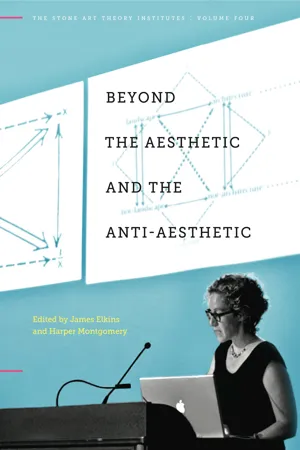
- English
- PDF
- Available on iOS & Android
Beyond the Aesthetic and the Anti-Aesthetic
About This Book
Each of the five volumes in the Stone Art Theory Institutes series, and the seminars on which they are based, brings together a range of scholars who are not always directly familiar with one another's work. The outcome of each of these convergences is an extensive and "unpredictable conversation" on knotty and provocative issues about art. This fourth volume in the series, Beyond the Aesthetic and the Anti-Aesthetic, focuses on questions revolving around the concepts of the aesthetic, the anti-aesthetic, and the political. The book is about the fact that now, almost thirty years after Hal Foster defined the anti-aesthetic, there is still no viable alternative to the dichotomy between aesthetics and anti- or nonaesthetic art. The impasse is made more difficult by the proliferation of identity politics, and it is made less negotiable by the hegemony of anti-aesthetics in academic discourse on art. The central question of this book is whether artists and academicians are free of this choice in practice, in pedagogy, and in theory.
The contributors are Stéphanie Benzaquen, J. M. Bernstein, Karen Busk-Jepsen, Luis Camnitzer, Diarmuid Costello, Joana Cunha Leal, Angela Dimitrakaki, Alexander Dumbadze, T. Brandon Evans, Geng Youzhuang, Boris Groys, Beáta Hock, Gordon Hughes, Michael Kelly, Grant Kester, Meredith Kooi, Cary Levine, Sunil Manghani, William Mazzarella, Justin McKeown, Andrew McNamara, Eve Meltzer, Nadja Millner-Larsen, Maria Filomena Molder, Carrie Noland, Gary Peters, Aaron Richmond, Lauren Ross, Toni Ross, Eva Schürmann, Gregory Sholette, Noah Simblist, Jon Simons, Robert Storr, Martin Sundberg, Timotheus Vermeulen, and Rebecca Zorach.
Frequently asked questions
Information
Table of contents
- COVER Front
- Series Page
- Copyright Page
- Table of Contents
- Series Preface
- Introduction (James Elkins)
- THE SEMINARS
- 1. Introductory Seminar
- 2. The Anti-Aesthetic in the 1980s: Craig Owens’s “The Allegorical Impulse”
- 3. The Anti-Aesthetic in the 1990s: The Body
- 4. Theory and Criticism
- 5. Theoretical Positions: Critical Theory
- 6. Theoretical Positions: Rancière, Deleuze, Relational Aesthetics
- 7. Theoretical Positions: Affect Theory in Art History
- 8. Theoretical Positions: Affect Theory at Large
- 9. Things Missing from this Book
- ASSESSMENTS
- Preface (Harper Montgomery)
- The October Revolution (Grant Kester)
- “This” (Alexander Dumbadze)
- The Chinese Reception (Geng Youzhuang)
- A Gaping Hole (Cary Levine)
- Not Aesthetics or Anti-Aesthetics But Poetics (Boris Groys)
- Ellipses and Détente (Gregory Sholette)
- What If We Really Have Bever Been Modern? (Eva Schürmann)
- Beyond Aesthetic and Anti-Aesthetic: Three Miniatures (Maria Filomena Molder)
- Get Over It! (Gary Peters)
- Beyond “Beyondness” (Andrew McNamara)
- Re: Re: Post (Gordon Hughes)
- The Elusive “Beyond” of Aesthetic and Anti-Aesthetic (Toni Ross)
- On Politics, Art, and Mobbing Rancière (Justin McKeown)
- As If (Timotheus Vermeulen)
- How Do You Pronounce the Politics of Aesthetics? (Noah Simblist)
- Remarkable Oversights, or Could We Actually Make Politics Easier to Talk About? (Rebecca Zorach)
- Adorno and Affect (Carrie Noland)
- Let’s Not and Say We Did (Robert Storr)
- Why Is Adorno So Repulsive? (William Mazzarella)
- Theory Cataracts (Luis Camnitzer)
- Moving Beyond: Aesthetics and Politics (Jon Simons)
- The Aesthetic, the Anti-Aesthetic, and Then What?: Why Answering this Question Involves Thinking About Art as Labor (Angela Dimitrakaki)
- Afterword: The Bathwater and the Baby (Gretchen Bakke)
- Notes on the Contributors
- Index
- COVER Back